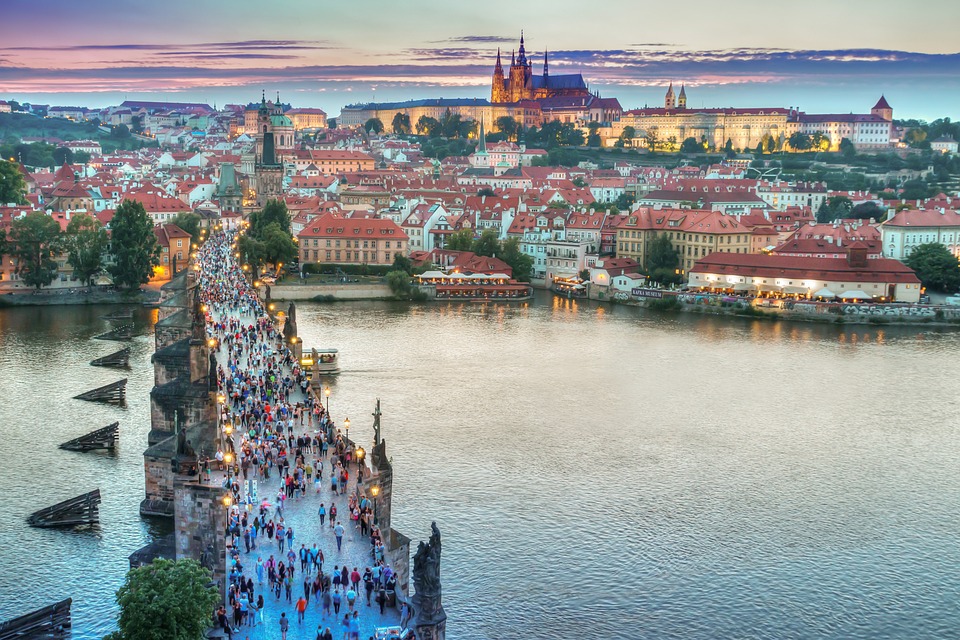 |
| Courtesy Pixabay |
The Charles Bridge is an icon of Prague, both beautiful and interesting. Completed in 1402, construction was commissioned by Czech king and Holy Roman Emperor Charles IV and began in 1357. In charge of the construction was architect Petr Parléř whose other works include the St. Vitus Cathedral at the Prague Castle. It is said that egg yolks were mixed into the mortar to strengthen the construction of the bridge. The bridge has its own legend. It’s said that construction began on Charles Bridge at 5:31am on July, 9 1357 and the first stone was laid by Charles IV himself. This timing was important because the notoriously superstitious king was into numerology and astrology and this specific time formed a palindrome (1357 9, 7 5:31) and would transfer more strength to the bridge itself. Make sure to touch the statue of St. John Nepomuk for good luck and make a wish to return to Prague.
Listen to music and get your caricature drawn. There’s
never a bad time to be on Charles Bridge; but go in the early morning or
evening to avoid crowds. It’s fun to get swept up in the magic of the darkened
sculptures, the lovely architecture all around you, the hustle and bustle of
people, and people selling their crafts.

Courtesy Pixabay
St.
Wenceslas Square.
There’s a gargantuan statue of King Wenceslas riding a horse. Wenceslas is
venerated as being a good and just king. In 935 his own brother plotted to kill
him, and now he’s considered to be a martyr, saint, and even has his own
Christmas carol, “Good King Wenceslas.” This is also a great area for shopping.
Follow
the narrow and windy cobble-stoned roads and step into the fairytale charm
of Old Town Square. The Astronomical Clock is one
of the most interesting sights in the square with hourly “performances” (daily
9am to 9pm).
 |
| Courtesy Pixabay |
So, he disabled the clock, and no one was able to repair it for the next hundred years. Finally, in 1552 it was repaired by Taborský and Klokotská. The mechanisms of the clock from over 600 years ago are still functional today. Every hour, on the hour you can watch to see the small wooden figures move.
The Prague
Castle is the breathtaking focal point of the Czech capital towering
above the Vltava River. It’s the ancient residence of Czech kings, the current
seat of the Czech President and to no surprise, also a UNESCO World
Heritage site.
 |
| Courtesy Pixabay |
Upon
reaching the top you’ll gaze at the rows of windows of the palace and the
spires that stretch toward the sky. Click here for tips for visiting Prague Castle.
It
is recommended to take a guided walking tour here. Some options are St. Vitus Cathedral, the Golden Lane, St
Wenceslas Chapel (the patron saint of Prague), and Basilica of St.
George.
Don’t
forget to stroll the Golden Lane and see the small streets, tiny doorways,
and beautiful trinkets. The lane was constructed in the 15th century when
emperor Rudolf II gave the space to the guards of the castle. But the space was
small, so families used stone, mud, and wood to create small spaces to live and
work. The name “Golden” comes from the myth that alchemists were trying to make
an “elixir of youth” but it also transformed metals into gold.
Malá
Strana (the Lesser Town) is the neighborhood tucked next to the Prague Castle which was
once home to a number of noble palaces and today retains its beautiful and
regal charm. According to The Telegraph,
“for a romantic walk straight out of a Fellini film, it’s hard to beat the
twisty, cobbled lanes of Prague’s Malá Strana district, where sonatas spill out
of palace windows and hushed baroque gardens appear behind great grandiose
gates. The city’s centuries-old architecture, barely scratched during the
Second World War, serves as a fitting backdrop to a lifestyle that gave us the
word Bohemian.” Grab a bite to eat at a
traditional restaurant. Walk the streets
and be sure to look up at the ancient buildings and burger houses. Go into St.
Nicholas Church for extravagant pink marble and a Baroque organ. This is
the largest of Prague’s churches founded by the Jesuits. A few steps away is
the Church of Our Lady Victorious and The Infant of Prague. Inside
you’ll find “The Infant of Prague,” a small ornate statue that attracts
visitors worldwide since it’s said that a monk had a vision of baby Jesus and
then made a wood figure of a child.
The Jewish
Quarter, one of the city’s most
peaceful and elegant areas, dates back to the 13th century and
is said to be the best preserved Jewish ghettos in all of Europe with six
synagogues, the Jewish Town Hall and the Old Jewish Cemetery.
 |
| Courtesy Pixabay |
 |
| Courtesy Pixabay |
 | |||
| Courtesy Pixabay |
No comments:
Post a Comment